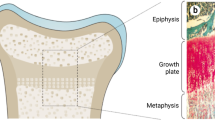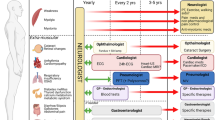Summary
Is is generally believed that because of the relatively high age of onset, early detection and genetic counselling in cases of myotonic dystrophy is difficult, if not impossible. Accordingly, clinical experience shows that the disease in many families was detected only after birth of the offspring, and was thus passed on over several generations. The aim of this study is to determine the age at which the expected rate of affection of 50% in the different sibs is found.
Ninety-seven individuals were examined in this study; they had originated from 18 different sibs. Of the total number of individuals examined, 55 belonged to the parental generation, the other 42 to the filial generation. Of the 97 patients, 53 suffered from myotonic dystrophy (36 parental, 17 filial generation). The expected penetrance of 50% was reached at less than 20 years in the affected families. The age of onset increased to 20–29 years if we consider the 19 individuals of the filial generation who could not be examined.
The most common subjective symptoms were cramps in the hands (49%), muscle weakness (23%), and indistinct speech and disturbances of swallowing (5%). Of the clinically affected individuals, 21% were found to be subjectively free of symptoms.
The most common objective signs were myotonic reaction (75=96%), facies myopathica and weakness of the m. orb. oculi (71=72%), weakness of the m. sternocleidomastoideus (71=72%) and m. tib. ant. (50=72%), and frontal baldness in the males (76=80%). A myotonic cataract was found in 37% of the cases using slit lamp examination.
The examinations for ABH secretor status and the Lutheran blood groups did not show a linkage in any of the families between the myotonic dystrophy gene and the secretor allel Se, or se respectively. Further the Lutheran blood group determination gave no new information.
Contrary to the prevailing opinion, it is concluded that genetic counsellig in cases of myotonic dystrophy is possible before advanced adult life. This study shows that the carriers of the disease can be identified with a simple clinical examination in the great majority of the cases before the age of 20.
Zusammenfassung
Nach der vorherrschenden Auffassung ist die Früherkennung und genetische Beratung der myotonen Dystrophie durch das relativ hohe Manifestationsalter erschwert oder unmöglich. Entsprechend zeigt die klinische Erfahrung, daß es zahlreiche Familien gibt, in der die Erkrankung erst nach der Erzeugung der Nachkommenschaft bemerkt und deshalb über mehrere Generationen vererbt wurde. Das Ziel dieser Untersuchung ist, zu klären, bis zu welchem Lebensalter in den betroffenen Sippen die zu erwartende Erkrankungshäufigkeit von 50% festzustellen ist.
Untersucht wurden 97 Personen aus 18 Sippen, von denen 55 der Elterngeneration und 42 der Filialgeneration angehören. 53 der 97 Personen litten an einer myotonen Dystrophie (36 Eltern-, 17 Filialgeneration). Die erwartete Penetranz von 50% wird in den betroffenen Familien unter 20 Jahren erreicht. Das Manifestationsalter erhöht sich auf 20–29 Jahre, wenn 19 nicht untersuchte Mitglieder der Filialgeneration berücksichtigt werden.
Die häufigsten subjektiven Symptome sind Krämpfe in den Händen (49%), Muskelschwäche (23%), verwaschene Sprache und Schluckstörungen (5%). 21% der klinisch Kranken waren subjektiv symptomlos.
Die häufigsten objektiven Befunde sind myotone Reaktion (75=96%), Facies myopathica und Schwäche des M. orb. oculi (71=84%), Schwäche des M. sternocleidomastoideus (71=72%) und M. tib.ant. (50=72%), Stirnglatze bei Männern (76=80%).
Mittels der Spaltlampenuntersuchung wurde bei 37% der Kranken eine myotone Katarakt nachgewiesen.
Die Untersuchung auf ABH-Sekretorstatus und Lutheran-Blutgruppen zeigte in keiner der untersuchten Familien die Kopplung des Gens für myotone Dystrophie mit dem Sekretorallel Se bzw. se. Auch die Lutheran-Blutgruppenbestimmung lieferte keine Information. Die vorherrschende Meinung, daß die genetische Beratung für die myotone Dystrophie erst im vorgerückten Erwachsenenalter möglich ist, ist nicht zutreffend. Unsere Studie zeigt, daß in der überwiegenden Mehrzahl der Fälle die Träger der Anlage vor dem 20. Altersjahr durch eine einfache klinische Untersuchung identifiziert werden können.
Similar content being viewed by others
References
Becker, P. E.: Humangenetik. Ein kurzes Handbuch in 5 Bänden. Bd III/1. Stuttgart: Thieme 1964
Bundey, S., Carter, C. O.: Early recognition of heterozygotes for the gene for dystrophia myotonica. J. Neurol. Neurosurg. Psychiat. 33, 279–293 (1970)
Bundey, S.: Detection of heterozygotes for myotonic dystrophy. Clin. Genet. 5, 107–109 (1974)
Harper, P. S., Rivas, M. L., Bias, W. B., Hutchinson, J. R., Dyken, P. R., McKusick, V. A.: Genetic linkage confirmed between the locus for myotonic dystrophy and the ABH-secretion and Lutheran blood group loci. Am. J. Hum. Genet. 24, 310–316 (1972)
Harper, P. S.: Pre-symptomatic detection and genetic counselling in myotonic dystrophy. Clin. Genet. 4, 134–140 (1973)
Harper, P. S.: Myotonic dystrophy: some genetic problems. Birth Defects, Vol. X, No. 10, pp. 120–125 (1974)
Klein, D.: La dystrophie myotonique (Steinert) et la myotonie congénitale (Thomsen) en Suisse. J. de Génét. Hum., Suppl. au Vol. 7 (1958)
Kuhn, E.: Studien zur Pathogenese der myotonischen Dystrophie. Berlin, Heidelberg, New York: Springer 1961
Lynas, M. A.: Dystrophia myotonica with special reference to Northern Ireland. Ann. Hum. Genet. 21, 318–351 (1957)
Mohr, J.: A study of linkage in man. Copenhagen: Munksgaard 1954
Penrose, L. S.: The problem of anticipation in pedigrees of dystrophia myotonica. Ann. Eugen. 14, 125–136 (1948)
Polgar, J. G., Bradley, W. G., Upton, A. R. M., Anderson, J., Howat, J. M. L., Petito, F., Roberts, D. F., Scopa, J.: The early detection of dystrophia myotonica Brain 95, 761–776 (1972)
Renwick, J. H., Bundey, S. E., Ferguson-Smith, M. A., Izatt, M. M.: Confirmation of linkage of the loci for myotonic dystrophy and ABH secretion. J. Med. Genet. 8, 407–416 (1971)
Schrott, H. G., Karp, L., Omenn, G. S.: Myotonic dystrophy: Opportunities for prenatal prediction. Neurology 25, 789–791 (1975)
Stålberg, E.: Single fibre electromyography. DISA Information Department, 1974
Stålberg, E., Thiele, B.: Motor unit fibre density in the extensor digitorum communis muscle. J. Neurol. Neurosurg. Psychiat. 38, 874–880 (1975)
Walton, J. N.: Disorders of voluntary muscle. Churchill 1974
Zellweger, H., Ionasescu, V.: Myotonic dystrophy and its differential diagnosis. Acta Neurol. Scand., Suppl. 55, Vol. 49, 1973
Zimmerli, O., Moser, H., Lattke, F., von Matt, B., Gerber, H.: Die eugenische Bedeutung der Kopplung zwischen den Genloci für Dystrophia myotonica (M. Steinert) und ABH-Sekretor. Schweiz. Med. Wochenschr. 107, 327–335 (1977)
Author information
Authors and Affiliations
Rights and permissions
About this article
Cite this article
Schubert, T., Jerusalem, F., Martenet, AC. et al. Myotonic dystrophy—Early detection and genetic counselling. J. Neurol. 223, 13–22 (1980). https://doi.org/10.1007/BF00313136
Received:
Issue Date:
DOI: https://doi.org/10.1007/BF00313136




